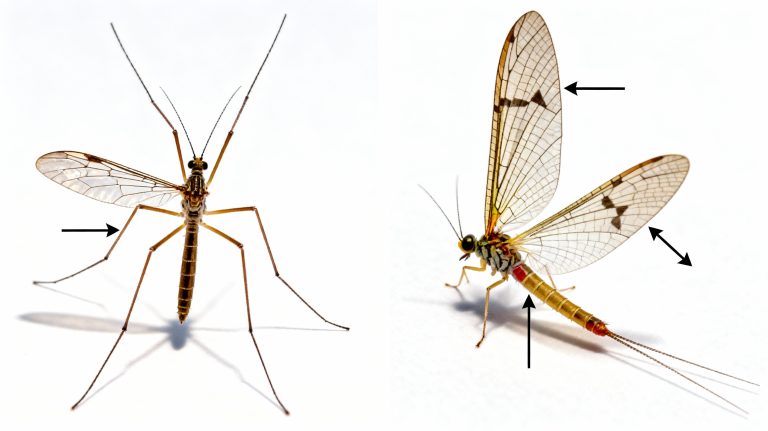I’ll be honest, I’ve stared at one of those spindly insects on my porch light and wondered if it was about to bite me. The long legs, shaky wings, and clumsy flight make them look like giant mosquitoes, but they’re not.
Most of the time, you’re seeing either a crane fly or a mayfly, two insects that look similar at first glance but are easy to tell apart once you know the trick. In this guide, I’ll show you the quick checks I use so you’ll never mix them up again.
Crane Fly vs Mayfly in 10 Seconds: Wings and Tails
-
Count wings. One pair of wings = crane fly. Two pairs = mayfly. You might see a tiny knob behind a crane fly’s wings (that’s a haltere, a fly thing). You’ll know in seconds: if you only see one large pair moving, it’s a crane fly.
-
Look for tail filaments. Mayflies have two or three long, hairlike tails sticking off the back. Crane flies never do. If you spot those threads, you’ve got a mayfly decision made right there.
Helpful tie breakers:
-
Resting posture: Mayflies park with their wings upright, like a little sail. Crane flies hold theirs flat or slightly spread.
-
Legs: Crane flies have comically long legs (often longer than the body). Mayflies’ legs are much more proportionate.
Note: most mayflies have two pairs of wings, but a few tiny species have reduced or missing hind wings. Those long tails remain the most reliable mayfly clue.
Crane Flies Up Close: ID Traits, Myths, and Life Cycle
Crane flies are true flies, despite the “mosquito hawk” nickname. They’re the lanky, wobbly fliers that bounce around porch lights in spring and fall.
Up close, you’ll see a straight, slender body, one pair of clear wings, and legs so spidery they fall off if you handle them roughly. No stinger, no biting beak. They can’t bite you, and they don’t hunt mosquitoes, a big myth.
Adults mostly live a few days to a week or two, mate, and call it a life. The larval stage (in soil or soggy thatch) is where the feeding happens.
In very wet, cool regions, think the Pacific Northwest, heavy populations of European crane fly larvae (“leatherjackets”) can scuff up lawns by nibbling grass roots.
For most yards, though, adults are just clumsy, harmless visitors that bump into windows and forget how to exit a room.
Mayflies at a Glance: Wings, Tails, Habitat, Lifespan
-
Wings: two pairs that look triangular. At rest, they sit upright like a tent. The hind wings are smaller, and in some small species, they’re tiny or absent.
-
Tails: two or three long filaments, unmistakable once you see them.
-
Where you see them: near lakes, rivers, and streams. Big emergences can coat bridges and boats.
-
Behavior: weak fluttering flight. They gather at lights and on walls in huge numbers during brief hatches.
-
Lifespan: adults are the definition of “ephemeral,” often hours, sometimes a day. They don’t bite or feed. They’re here to mate, lay eggs, and end the story.
If you fish, you already know the vocabulary: drakes, spinners, “the hatch.” Those terms are all about mayflies.
Why the Mix-Up Happens: Different Orders, Simple Checks
Both insects are delicate, both show up at lights, and both get called “mosquito something” by well meaning neighbors including the crane fly nickname myth.
But they’re from entirely different branches of the insect tree: crane flies are flies (one functional wing pair), mayflies are their own ancient order (usually two wing pairs, plus those signature tails).
That’s why the wings and tails check is so decisive; it’s tied to what they are, not just how they look in bad lighting.
Look Alikes to Rule Out Fast: Mosquitoes, Midges, Caddisflies
-
Mosquitoes: Much smaller than crane flies, hump backed, and they have a long, needle-like snout (proboscis). If you see a beak, it’s a mosquito, not a crane fly or mayfly.
-
Non-biting midges: Little “mosquito look-alikes” that swarm at dusk. One pair of wings, no tails. If it’s tiny and tailless, it’s a midge, not a mayfly.
-
Caddisflies: Near water with tent-shaped, hairy wings held roof-like over the body. No tails. They look “moth-ish,” not sail-winged like a mayfly.
-
Stoneflies: Two-tailed threads like mayflies, but wings lie flat over the back (not upright) when resting. Bodies look flatter and more robust.
-
Damselflies: Dragonfly cousins with long stick-like abdomens and huge eyes. Two pairs of wings, no tails, and much stronger fliers than mayflies.
One more naming tangle: “daddy longlegs” gets used for crane flies in some places and for a spider relative (harvestmen) in others. If it’s got wings, you’re in crane fly territory, not arachnid land.
When and Where to Expect Them: Seasons, Places, Lights
Crane flies tend to surge in spring and fall, especially after rain irrigates lawn edges, fields, and woodland margins. They wander into garages and onto patios and seem magnetized to porch lights. If you see a gangly “giant mosquito” indoors in October, that’s a crane fly looking for the moon and settling for your lamp.
Mayflies are a water story. Their nymphs live in streams and lakes, and the adults rise in sudden bursts, regional and seasonal, but often late spring through summer. In some places (Great Lakes, big rivers), a hatch can turn radar screens fuzzy and leave morning piles of spent adults under streetlights.
Like most hatches, they’re gone almost as quickly as they arrived. Good sign: by the next morning or two, the “mayfly blizzard” will have vanished on its own.
If the lights are attracting more insects than you’d like, try using warmer-colored LEDs or switch off unnecessary outdoor lights for a couple of evenings. You’ll notice the difference immediately the first night.
Quick Answers: Bites, Lawn Risk, and Easy Memory Trick
Crane flies don’t bite. They don’t sting. They’re not hunting you or your mosquitoes, whereas dragonflies and mosquito control focus on that. If they blunder indoors, they’ll either find their way out or expire in a day or two.
Mayflies don’t bite either. They’re indicators of clean water nearby, and their adult stage is so short that “problem” is the wrong word. Sweeping them up is usually all that’s needed after a hatch.
Worried about lawn damage? Only a handful of crane fly species’ larvae cause turf issues, mostly in consistently cool, wet climates.
If your lawn is browning in irregular patches and birds are pecking the soil in early spring, that’s when it’s worth a closer look, but for most of the country, adult crane flies on the porch are a non-issue.
Bottom Line that You Can Remember
No tails + One wing pair = Crane fly.
Tails + Upright wings = Mayfly.
If you’re still unsure, take a quick photo and zoom in so those tails show up like neon. Either way, you’ve met a harmless neighbor doing its brief, ancient routine. You’ve got this.













